Appendicular Skeleton
1/80
There's no tags or description
Looks like no tags are added yet.
Name | Mastery | Learn | Test | Matching | Spaced |
|---|
No study sessions yet.
81 Terms
Appendicular Skeleton Consists of
Paired Fins (or limbs) and Girdles
Paired fins
Limbs or fins that are arranged in pairs, providing stability and locomotion in aquatic animals.
Girdles
Structures that support paired fins or limbs, such as the pectoral and pelvic girdles.
Pectoral girdle
The structure that supports the pectoral fin or forelimb
Pelvic girdle
The structure that supports the pelvic fin or hindlimb. Hips
Fins
membranous or webbed processes, internally strengthened by thin, radiating fin rays
Fin rays
Slender, segmented elements that strengthen the fins. They initially form at the interface of dermis and epidermis (like scales) but then sinks into the dermis. Dermal in origin
Ceratotrichia
dermal fin rays of elasmobranchs that are slender and elastic, resembling keratin. Hair-like structures extending down within the fin that gives it flexibility.
Lepidotrichia
series of tiny ossified or chondrified elements in bony fishes that strengthen the web. Individual elements making up the rays, segmented.
Pterygiophores
supports the proximal (attached to the body) part of the fin in both chondrichthyans and bony fishes. Leads into the fin rays
Basals
enlarged, proximal, pterygiophore at the base of the fin
Radials
slender, distal, pterygiophore towards the middle of the fin
Single fin types
Dorsal, caudal, anal
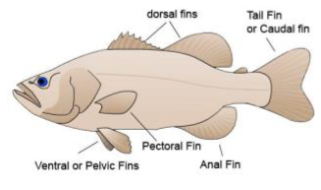
Paired fin types
pectoral and pelvic. phylogenetic precursors for arms and legs

chiridium
limb, muscular appendage that has well-defined joints with digits at the distal end
Limbs of tetrapods: Autopodium
The distal end of a limb, including the wrist/ankle, manus/pes (instead of hand and feet) and digits.
Why manus and pes instead of hands and feet
Hands can only technically be used for primates because indicate grasping. Feet can only technically be used for bipeds because they indicate standing
Limbs of tetrapods: Zeugopodium
The middle region of a limb, consisting of bones like the ulna and radius or tibia and fibula.
Limbs of tetrapods: Stylopodium
The proximal region of a limb, containing the humerus or femur.
Glenoid fossa (cavity)
depression in the pectoral girdle that articulates with the humerus. Head of humerus connects with pectoral girdle (scapula)
Acetabulum
A deep socket in the pelvic girdle that articulates with the femur. Nice deep round structure where the femur head connects
Basic components of manus and pes
the digits begin proximally with the metacarpals/metatarsals and lead into the chain of phalanges. They rest on the carpals/tarsals.
Bones of the manus
several phalanges (3 or 2 in the thumb)
5 metacarpals
carpals
Carpal bones
radiale (connect with the radius), 3 centrales (in between), and ulnare (connect with the ulna)
Bones of the pes
cannon bone: formed by a fusion of metatarsal III and IV (in bovids and cervids)
tarsometatarsus: fusion of lower tarsals and metatarsals (in birds)
calcaneum: fibulare bone (connects with the fibula)
astragalus: tibiale bone (often fuses with intermedium)
Phylogenetic precursors
Structures that evolved into modern limbs, such as pectoral and pelvic fins.
origin of paired fins: deviations from the line of travel
may swing side to side (yaw), rock about the long axis (roll), or buck forward or backward/up and down (pitch).
Pelvic fins were for stabilization and pectoral fins are for locomotion
Archipterygial fins
chain of basals (gray) run down the middle of the fin, radials (white) project outward to support the preaxial (anterior) and postaxial (posterior) sides of the evenly. Found in sarcopterygians. Turn into limbs

Metapterygial fin
the basals are located posteriorly and most radials project to the preaxial side of the fin. Likely evolved first because they are common in gnathostomes.
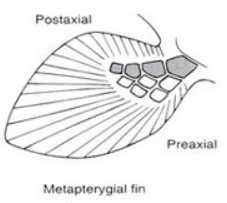
Gill-Arch Theory
A hypothesis suggesting that paired fins and girdles evolved from gill arches. Girdle arose from gill arch, archipterygial fin arose from gill rays. Does not explain pelvic fins and girdle because it doesn’t make sense spatially.
Fin-Fold Theory
A theory proposing that paired fins arose from a paired, continuous ventrolateral fold in the body wall that became stiffened by the endoskeletal pterygiophores. Basals extended inward and fused to form girdles and dermal bone was later added. Supported because ancient lampreys look they have folded fins and because of embryonic studies.
Shift to Tetrapods
Stylopodium appears first (humerus/femur). It branches out to the preaxial (radius/tibia) and postaxial (ulna/fibula) forming the zeugopodium. Postaxial subdivides into the autopodium (manus/pes), preaxial contributes to carpals/tarsals.
Modifications of pectoral and pelvic appendages
claspers: modifications to the pterygiophores of the pelvic fins in males, used in mating in sharks
pelvic girdle moved forward to reside with the pectoral girdle in teleosts
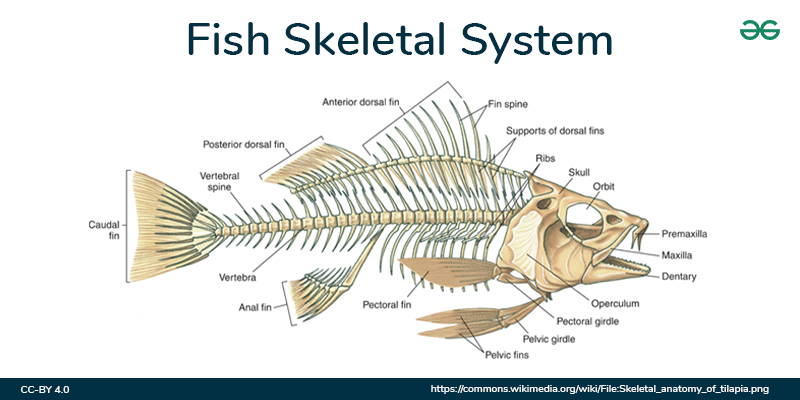
Chondrichthyes phylogeny
Have 3 enlarged basal pterygiophores in pectoral fins called metapterygium, mesopterygium, and proterygium
Metapterygial stem of the pelvic girdle consists of postaxial series
coracoid bar (pectoral girdle) doesn’t articulate with the skull
ischiopubic bar (pelvic girdle) is a single solid element and doesn’t articulate with the axial skeleton. Free floating, associated with the body wall
fin rays called ceratotrichia
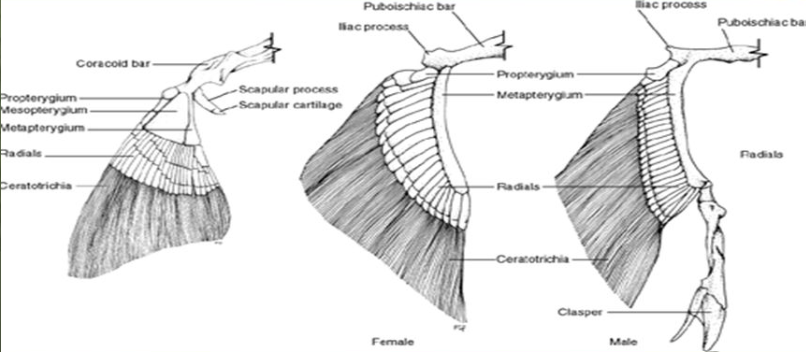
Actinopterygii phylogeny
pectoral girdle forms a u-shaped collar of bone just behind the gill chamber and articulates with the skull
scapulocoracoid is the connection point with the fin, acts as a support
pelvic girdle has shifted forward under the pectoral fins
have lepidotrichia fin rays
have metapterygial fins
Bone types of the pectoral girdle in Actinopterygii (bony fishes)
cleithrum, clavicle, supracleithrum, postcleithrum (not in all species), and scapulocoracoid
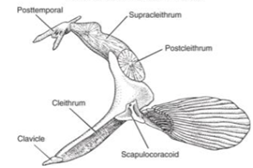
cleithrum
largest element of the girdle, articulates with scapulocoracoid
clavicle
meets with the cleithrum and the other clavicle (at the symphysis)
supracleithrum
articulates with the cleithrum and posttemporal (skull) bone. Dorsal
Sarcopterygii phylogeny
early lobe-finned fishes contain fin elements that are similar in structure to limbs of early tetrapods
extant coelacanths and lungfishes fins are reduced compared to ancestors
pectoral girdle contains cleithrum, clavicle, postcleithrum (swapped out supracleithrum), and scapulocoracoid
pelvic fin articulates with a single girdle bone, assiciated with the body wall, free-floating
extinct species had interclavicle that was retained in the pectoral girdle of later tetrapods
Tetrapods phylogeny
early tetrapods quickly acquired modifications associated with locomotion on land. Robust bones to withstand gravity
Amphibians pectoral girdle
now firmly attached to the axial skeleton, provides ventral support. No direct connection to the skull because we now have a neck
consists of clavicle, scapula, procoracoid (scapulocoracoid split), cleithrum and interclavicle (not all have these)
Amphibian forelimb
pectoral girdle aticulates with the forelimb at the glenoid cavity
Bones of the limb are humerus (upper arm), radioulna (fusion of radius and ulna to support weight with jumping), and the manus
Amphibian pelvic girdle
Salamanders have puboischia (fused pubis and ischium) and ilium
Anurans have ilium, ischium, and urostyle (instead of pubis)
joins medially at the symphysis
articulates with the femur in the hindlimb at the acetabulum
Urostyle
additional articulation between the vertebral column and sacrum, providing support and helping to maintain posture
Amphibian hindlimb
leg articulates with the pelvic girdle at the acetabulum
bones include femur, tibiofibula (fusion to provide strength and absorb shock for the big jumping motions), and pes
no patella
Reptiles + Birds pectoral girdle
generally consists of scapula, procoracoid, coracoid, clavicle, and interclavicle. (no cleithrum in amniotes)
Crocodilian variation of pectoral girdle
lacks clavicle but still has interclavicle (very small and near the sternum)
Snake variation of pectoral girdle
not present
Turtle variation of pectoral girdle
clavicles and interclavicles are incorporated into the plastron (entoplastron)
Bird variation of pectoral girdle
clavicles fuse with the interclavicles to form the wishbone (furcula).
side note: giant sternum is called the keel
Reptile forelimb
consists of humerus radius, ulna, and manus
Bird forelimb
forelimb lengthened and went through a reduction and fusion of digits for flight. Have radius, ulna, radiale, ulnare, fused metacarpals, 3 phalanges
os coxa
having a 3 ilium, ischium, and pubis bones fused together
Reptile + Bird pelvic girdle
os coxa
pubis bones join at the pubic symphysis
not in birds, they have a nice open passage for eggs to be able to move through the birth canal
Reptile hindlimb
bones include the femur, patella, tibia, fibula, and pes
Bird hindlimb
tarsals fuse with tibia to create tibiotarsus
2nd layer of tarsals fused with the metatarsals to become tarsometatarsus
Walk on their toes
still have femur, patella, fibula, and phalanges
Mammals pectoral girdle
clavicle reduced in size
scapula becomes dominant
the coracoid fuses to the scapula to become the coracoid process
monotremes still have interclavicle
Mammal forelimb bones
humerus, radius, ulna, manus
mammal pelvic girdle
os coxa
mammal hindlimb bones
femur, tibia, fibula, pes, and patella
Manus and pes modifications
ancestral state is pentadactyly (5 digits)
marine mammals have polyphalangy (multiple bones per digit (phalanxes) instead of just 3 or 2) to extend the hand and increase surface area to move themselves through the water
ungulates have fusion of phalanxes that reflects how they move
Swimming form and function
streamlined form to promote lamellar flow, reduce turbulence and drag
lateral undulations used to produce a back thrust and propel the animal
Secondarily aquatics
loss of hindlimbs (whales and dolphins), modified postures in seals and sea lions where they hold the hindlimbs together so that it functions like a single caudal tail when they swim
Aquatic birds evolved robust forelimb bones to create more surface area and better push themselves through the water
Gait
pattern of contact (footfalls) with substrate (land) during locomotion. 2 types: diagonal or lateral sequences
diagonal sequence
diagonally opposite feet strike the ground in unison. Most common gait in tetrapods. Reptiles and salamanders do this. Provides stability in sprawling posture
lateral sequence
feet of the same side strike the ground in unison. Common in mammals. Erect posture, evolved in running
Cursorial locomotion
Running
Cursorial locomotion speed is determined by
stride length: influenced by foot posture (plantigrade or digitigrade).
digitigrade increases the stride length because it increases limb length
stride rate: rate at which limbs are moved
short limbs increase stride rate but decreases stride length
lighter distal portions of legs will increase rate by decreasing mass
Saltatorial locomotion
Hopping
saltatorial locomotion favors
enlarged feet on the propulsive limbs, center of mass towards the rear, large/robust hindlimbs, long tail to act as counterbalance (except bunnies)
Scansorial locomotion
Climbing in trees (type of arboreal)
Scansorial locomotion favors
claws coming off digits, small body size, prehensility, suspensory structures
prehensility
appendage that can wrap around something. ex) porcupine tail or sloth claws
Brachiation locomotion
swinging in trees (type of arboreal)
Brachiation locomotion favors
broad thorax to accommodate lots of muscles for swinging and hanging, forelimbs longer than hindlimbs, mobile shoulder joint (ball and socket joint with robust range of motion), either no tail or prehensile tail (semi brachiators)
Fossorial locomotion
digging or burrowing
Fossorial locomotion favors
large claws or incisor teeth to help them dig through the sediment, short, broad forelimbs (like little shovels/paddles), forelimbs splayed to the side (sprawling posture), vibrissae (whiskers), small eyes, no pinnae (outer ear) so dirt doesn’t get into it
Aerial locomotion
Movement through the air, including gliding/parachuting and flying.
Gliding/Parachuting favors
a patagium (flap of skin)
ex) bats, sugar gliders, flying squirrels, scary flying snake
Flight favors
wings (with or without feathers) from modified forelimb, streamlined body (lamellar flow), large sternum to accommodate flight muscles, decreased mass (help with lift), wing shape reflects type of flight